European Collection of Imari and Rococo Naturalism
In Europe, there are many Oriental porcelain collections including early Imari ware. It has certain tendency since mid-17th century, trend and the class were different in each country, such as the Netherlands, UK, France and Germany.
Oranienburg Palace, Germany
Until 1663 the Porcelain Room already existed in Oranienburg Palace in Germay. In 1646, Louise Henriette (1627-1667) of Orange-Nassau, who was born at Den Haag in Holland, married Friedrich Wilhelm I of Brandenburg (1620-1688). She was so attracted by the town of Boetzow, that her husband presented the entire region to her. The princess ordered a new castle to be built in Dutch style and called it Oranienburg. In 1653, the town of Boetzow was renamed Oranienburg. She probably brought her porcelain collection from Holland of which the East India Company dominated the porcelain trade with China and Japan at that time.
Le Trianon de Porcelaine, France
In 1670 Le Trianon de Porcelaine was build as a tea-house by Louis XIV (1638–1715) for his mistress, Madame de Montspan (1640-1707). The King purchased Trianon, a hamlet on the outskirts of Versailles, and commissioned the architect Louis Le Vau (1612–1670) to design a porcelain pavilion (Les Trianon de porcelaine) to be built there. The façade was made of white and blue Delft-style "porcelain" (ceramic) tiles from the French manufactures of Rouen, Lisieux, Nevers and Saint-Cloud. Construction began in 1670 and was finished in 1672. The Grand Trianon was located in the northwestern part of the Domain of Versailles where the King and invited guests could take light meals (collations) with tea away from the strict etiquette of the Court. The Grand Trianon is set within its own park, which includes the Petit Trianon (the much smaller chateau built between 1762 and 1768 during the reign of Louis XV).
Hampton Court Palace, UK
In late 1680s Queen Mary II (1662-1694) made the famous collection of porcelain in Hampton Court Palace. Soon after their accession to the English throne, King William III(r 1689-1702), Willem III of Orange-Nassau, and Queen Mary II (r 1689-94) commissioned Sir Christopher Wren to rebuild Hampton Court.
Burghley House, UK
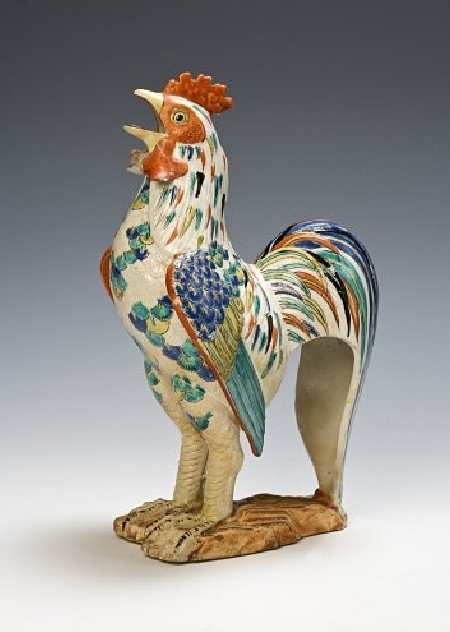 A figure of a cockerel, Japanese, circa 1660/80, shown modelled in a crowning attitude, with head erect and beak open standing on a rockwork base, its tail feathers meeting the base and forming third support, the plumage moulded and detailed in a strong Kakiemon palette, the base washed in iron oxide, 28cmThe inventory of the household goods of the fifth earl and countress of Exeter taken in 1688 includes pieces of Japanese Porcelain that are still in Burghley House. This makes those pieces, the earliest recorded Japanese porcelains in Europe, the earliest examples where we can confidently equate a seventeenth-century description with a specific extant object.
A figure of a cockerel, Japanese, circa 1660/80, shown modelled in a crowning attitude, with head erect and beak open standing on a rockwork base, its tail feathers meeting the base and forming third support, the plumage moulded and detailed in a strong Kakiemon palette, the base washed in iron oxide, 28cmThe inventory of the household goods of the fifth earl and countress of Exeter taken in 1688 includes pieces of Japanese Porcelain that are still in Burghley House. This makes those pieces, the earliest recorded Japanese porcelains in Europe, the earliest examples where we can confidently equate a seventeenth-century description with a specific extant object.
The secenteenth-century Chinese and Japanese porcelains at Burghley can be divided into four groups if we considered their arrival in the house only. The first group consists of the Chinese and Japanese porcelains that are inventoried, that were in the house before 1688. Second is the group of porcelains, nearly all Chonese, that came to the house in 1690 under the will of the coutress of Devonshire to her daughter Ann, the countress of the fifth earl. Third is a group of Japanese porcelain, the majority blue and white, that were mostly not made specifically as export pieces and therefore must have been collected as "curiosities" in Japan by some Dutch trader, who sold them in turn to a British retailer who sold them on to three houses, Burghley, Drayton House and Welbeck Abbey in the last decade of the seventeenth century. Fourth are all the pieces that are not accounted for above; this have been the largest group.
The collection at Burghley House is extensive, but it was once larger; there was a sale at Chiristie's in London on June 7 and 8, 1888, that included a considerable amount of "old Oriental porcelain". There was another sale at Christie's on July 13 1959, of English, Continental and Oriental porcelain, all from Burghley House. This included three lots described as Japanese.
Burghley House, 16th-century country house near the town of Stamford, Lincolnshire, England, was built for Sir William Cecil (1521–1598), later 1st Baron Burghley, who was Lord High Treasurer to Queen Elizabeth I, between 1558 and 1587 and modelled on the privy lodgings of Richmond Palace. It was subsequently the residence of his descendants, the Earls and Marquesses of Exeter, and since 1961 is owned by a charitable trust established by the family.
Charlottenburg Palace, Germany
 Porcelain room of Charlottenburg Palace in Berlin. Circa early 18th century.In 1706 the Porcelain Room, with its valuable collection of Chinese and Japanese porcelain, build in Charlottenburg Palace in Germany. It is designed by Johann Friedrich von Eosander.
Porcelain room of Charlottenburg Palace in Berlin. Circa early 18th century.In 1706 the Porcelain Room, with its valuable collection of Chinese and Japanese porcelain, build in Charlottenburg Palace in Germany. It is designed by Johann Friedrich von Eosander.
The original palace, named Lietzenburg derived from the name of village Lietzow, was commissioned by Sophie Charlotte (1668-1705), the wife of Friedrich III (1657–1713), Elector of Brandenburg. It was designed by Johann Arnold Nering (1659-1695) in baroque style. Friedrich III crowned himself as King Frederick I of Prussia in 1701. In 1699 he had appointed Johann Friedrich von Eosander as the royal architect and sent him to study architectural developments in Italy and France, particularly the Palace of Versailles. On his return in 1702 Eosander began to extend the palace. In 1705 Sophie Charlotte died and Friedrich III named the palace and its estate Charlottenburg in her memory. In the following years the Orangery was built on the west of the palace and the central area was extended with a large domed tower and a larger vestibule. The Orangery was originally used to overwinter rare plants.
Inside the palace was a room described as "the eighth wonder of the world", the Amber Room (Bernsteinzimmer), a room with its walls surfaced in decorative amber. It was designed by Andreas Schlüter and its construction by the Danish amber craftsman Gottfried Wolfram started in 1701. Friedrich Wilhelm I gave the Amber Room to Tsar Peter the Great(1672-1725) as a present in 1716.
Japanese Palace, Saxony, Germany
 A pair of Meissen porcelain herons made in 1732 for the Japanese Palace in Dresden,
Germany; at Christie’s Paris in June 2005, they fetched $6.8 million.The Japanese Palace/Japanisches Palais, which was enlarged in Baroque and neo-classical style in 1727-37 under the direction of M. D. Pöppelmann, is richly decked with chinoiserie. Originally built to house Augustus the Strong's collection of porcelain.
A pair of Meissen porcelain herons made in 1732 for the Japanese Palace in Dresden,
Germany; at Christie’s Paris in June 2005, they fetched $6.8 million.The Japanese Palace/Japanisches Palais, which was enlarged in Baroque and neo-classical style in 1727-37 under the direction of M. D. Pöppelmann, is richly decked with chinoiserie. Originally built to house Augustus the Strong's collection of porcelain.
In 1730 Augustus the Strong (1694/7-1733), Elector of Saxony and King of Poland, one of the wealthiest monarchs and most important patrons of the arts of his age, planed to fill the upper floor of the Japanese Palace with a large group of porcelain animals and birds made by the Meissen Porcelain factory.
The ambition of Augustus's project cannot be overemphasised, and it still remains unparalleled in the history of ceramics. The order for these large beasts came only 20 years after the foundation of the Meissen factory, the first European factory to succeed in the manufacture of 'true' (or hard-paste) porcelain of the Chinese type. Meissen's discovery of the means of making porcelain was the direct result of Augustus the Strong's passion for imported Far Eastern wares, which led him to amass a collection of over 20,000 pieces (among them 151 Chinese vases exchanged for a unit of 600 cavalrymen), and to employ, and briefly imprison, the alchemist J. F. Böttger to discover the formula for this 'white gold'.
The size of the project is also extraordinary. According to a list of 1734 as many as 597 animals and birds were projected for the palace. Most were to have been produced in editions of eight from moulds made from original models provided by the sculptors discussed below. While in the event this quantity of figures was not realised, an inventory lists as many as 458 examples at Dresden in 1736, but many were much smaller birds and animals than this piece. Not surprisingly, their production became such a drain on the factory’s output and resources that work on the scheme was abandoned sometime before 1739.
Export of Imari
Since the start of the official export to Europe in 1657, lots of Imari ware had been crossed the ocean for nearly 100 years. And during those 100 years, Imarai ware had changed their style drastically from early stage blue-and white Huyou-de (imitating Chinese Kraak ware), Kakiemon style, then gold-painted Kinran-de style, which includes great-flamboyant masterpieces.
On April 24, 1644 the Ming capital Beijing fell to a rebellion led by Li Zicheng 李自成 and the last Ming Emperor Chongzhen committed suicide marking the official end of the Ming Dynasty. The Manchus led Qing Dynasty, then allied with Ming Dynasty general Wu Sangui 吳三桂, seized control of Beijing and overthrew Li's short-lived Shun Dynasty. However the regimes loyal to the Ming throne survived in the southern part of China as Southern Ming Dynasty until 1662.
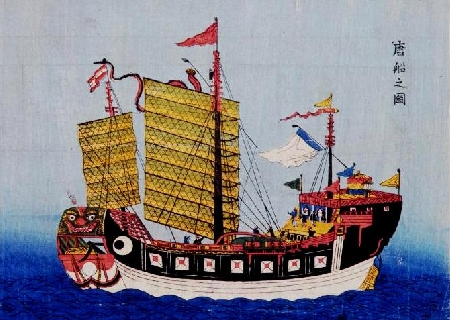 Zheng Chenggong 鄭成功 (Koxinga 國姓爺) (1624-1662), who was born in Hirado 平戸 to a Chinese merchant/pirate father Zheng Zhilong 鄭芝龍 (1604-1661) and his Japanese wife Tagawa Matsu 田川マツ (1601-1641), a daughter of a Tagawa Shitizaemon 田川七左衛門 in Hirado domain 平戸藩, was a Ming loyalist and the arch commander of the Ming troops on the maritime front. He devoted the last 16 years of his life to resisting the conquest of China by the nomadic Manchus, Qing Dynasty and oraganized 3000 ships and 170,000 people as a protestant troop. Upon defeating the forces of the Dutch East India Company (VOC) on Formosa (Taiwan), the Dutch Governor of Taiwan, Frederik Coyett, surrendered Fort Zeelandia to Koxinga on 1 February 1662. Koxinga then devoted himself to transforming Taiwan into a military base for loyalists who wanted to restore the Ming Dynasty.
Zheng Chenggong 鄭成功 (Koxinga 國姓爺) (1624-1662), who was born in Hirado 平戸 to a Chinese merchant/pirate father Zheng Zhilong 鄭芝龍 (1604-1661) and his Japanese wife Tagawa Matsu 田川マツ (1601-1641), a daughter of a Tagawa Shitizaemon 田川七左衛門 in Hirado domain 平戸藩, was a Ming loyalist and the arch commander of the Ming troops on the maritime front. He devoted the last 16 years of his life to resisting the conquest of China by the nomadic Manchus, Qing Dynasty and oraganized 3000 ships and 170,000 people as a protestant troop. Upon defeating the forces of the Dutch East India Company (VOC) on Formosa (Taiwan), the Dutch Governor of Taiwan, Frederik Coyett, surrendered Fort Zeelandia to Koxinga on 1 February 1662. Koxinga then devoted himself to transforming Taiwan into a military base for loyalists who wanted to restore the Ming Dynasty.
Under the turbulent situation Chinese ceramic production in Jingdezhen 景德鎮, southern part of China, declined rapidly. The Dutch East India Company was forced to find out an alternative porcelain and set the Arita region of Japan as another center of porcelain production.
The Beginning and Prosperity of Exports to Europe (1660-1670s)
 The export route of Imari by the Dutch East India Company.In 1650 the Dutch East India Company ship exported 145 pieces of "shoddy" porcelains to the trading factory at Tonking in Vietnam and the cumulative number of the exported porcelain reached to 15,392 pieces until 1656.
The export route of Imari by the Dutch East India Company.In 1650 the Dutch East India Company ship exported 145 pieces of "shoddy" porcelains to the trading factory at Tonking in Vietnam and the cumulative number of the exported porcelain reached to 15,392 pieces until 1656.
At the same time Chinese abroad "Huaqiao 華僑" living in Tonkin also exported quite many pieces of "shoddy" porcelain from Nagasaki.
In 1675 it was the first time that the Dutch East India Company exported some sample pieces of Imari to Holland.
In 1658 the Dutch ship exported 5,257 pieces of porcelain to Holland while 7 Chinese ships exported tens of thousands pieces of "shoddy" porcelain from Nagasaki.
On 15th October 1659, the Dutch East India Company ship "VOGELZANG" loading a cargo of 5,748 pieces of porcelain and other ceramics on board sailed out from Nagasaki to Holland through Batavia. In the same year, 5 Dutch ships exported 33,910 pieces of porcelain to Batavia, Holland, Moca, Surat and Coromandel in India.
Since the start of the official export to Europe in 1657, lots of Imari ware had been crossed the ocean for nearly 100 years. And during those 100 years, Imarai ware had changed their style drastically from early stage blue-and white Huyou-de (imitating Chinese Kraak ware), Kakiemon style, then gold-painted Kinran-de style, which includes great-flamboyant masterpieces.
I think the naturalistic designs, especially on Kakiemon-style ware, inspired Rococo Naturalism directly.
History of Imari ware
The Imari porcelain was also established by a kidnapped Korean, Yi Sam-pyeong 李参平 (1579–1655), who was brought by the Lord of Hizen 肥前, Nabeshima Naoshige 鍋島直茂 (1537-1619) with his extended family (180 persons) after the Japanese invasion in Korea in 1598. At that time several thousand other artisans were abducted by Japanese invaders ordered by Toyotomi Hideyoshi (1536-1598).
Yi Sam-pyeong, forced to use Japanese name Kanagae Sanpei 金ヶ江三兵衛/金江三兵衛, is considered as the father of Imari porcelain (Arita porcelain) in Japan. He is honored in a Shinto Shrine, Sueyama-Jinja 陶山神社 as the Father of Arita porcelain 有田焼. He was born in Chungcheongnam-do忠清南道, Jinjiang 金江, Korea under Joseon Dynasty.
Shoki Imari 初期伊万里 (Early Imari) ware (Early 17th century)
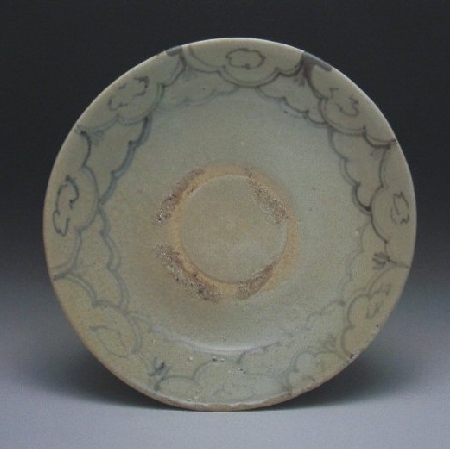 Very Early Shoki-Imari dish, circa 1610s.In 1616 (or 1604), he discovered a Kaolin deposit on Izumiyama 泉山 mountain in the eastern part of Arita 有田, and established the Tengudani-kiln 天狗谷窯 there. This is said to be effectively the start of Japanese porcelain production however the recent research unveiled that a few porcelain kiln, the Tenjinmori-kiln 天神森窯 and the Komizo-kiin 小溝窯 in the western parts of Arita started to make portcelain in the early 1610s before the Tengudani-kiln 天狗谷窯. The kilns at Arita formed the heart of the Japanese porcelain industry.
Very Early Shoki-Imari dish, circa 1610s.In 1616 (or 1604), he discovered a Kaolin deposit on Izumiyama 泉山 mountain in the eastern part of Arita 有田, and established the Tengudani-kiln 天狗谷窯 there. This is said to be effectively the start of Japanese porcelain production however the recent research unveiled that a few porcelain kiln, the Tenjinmori-kiln 天神森窯 and the Komizo-kiin 小溝窯 in the western parts of Arita started to make portcelain in the early 1610s before the Tengudani-kiln 天狗谷窯. The kilns at Arita formed the heart of the Japanese porcelain industry.
At that time the imported Chinese blue and white porcelain made at Jingdezhen 景德鎮 in China under Ming Dynasty dominated the the markets around the world. In Europe, the Dutch East India Company imported the "Kraak" orcelain through Batavia in Java because they were not allowed to land in China. In Japan, among the Chinese blue and white porcelain, Shonzui 祥瑞 type was highly acclaimed by connoisseurs as utensils for the Japanese tea ceremony.
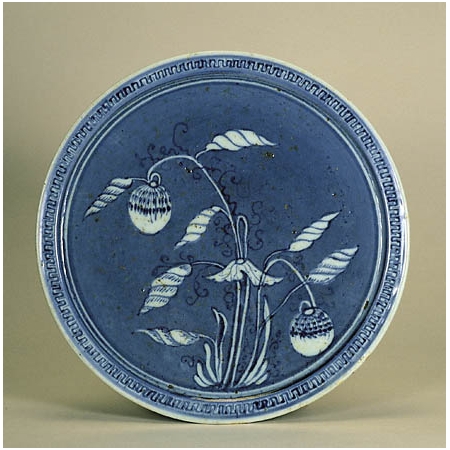 Shoki-Imari dish, circa 1640s. The surface is covered with a wash of cobalt blue, with the white design in reverse. At the time, large amounts of similar dishes were imported from China, and this dish was made in imitation of their form. diameters: 26.4cm. The Museum of Oriental Ceramics, Osaka.The main decorative techniques used during this period were underglaze cobalt blue and white, celadon glaze, iron glaze, and lapis lazuli blue glaze. The wares included not only items for daily use such as dishes, cups and bottles, but also utensils for the tea ceremony. Produced by pottery makers who had yet to fully master porcelain-making techniques, early Imari porcelains are characterized by their uneven tones of cobalt blue, slightly warped forms, and even the occasional fingerprint, but it is this very lack of refinement that imbues them with their interesting and charming naivete and sense of warmth.
Shoki-Imari dish, circa 1640s. The surface is covered with a wash of cobalt blue, with the white design in reverse. At the time, large amounts of similar dishes were imported from China, and this dish was made in imitation of their form. diameters: 26.4cm. The Museum of Oriental Ceramics, Osaka.The main decorative techniques used during this period were underglaze cobalt blue and white, celadon glaze, iron glaze, and lapis lazuli blue glaze. The wares included not only items for daily use such as dishes, cups and bottles, but also utensils for the tea ceremony. Produced by pottery makers who had yet to fully master porcelain-making techniques, early Imari porcelains are characterized by their uneven tones of cobalt blue, slightly warped forms, and even the occasional fingerprint, but it is this very lack of refinement that imbues them with their interesting and charming naivete and sense of warmth.
So the porcelain makers at Arita firstly imitated the Chinese bule and white ware and thier products were mentioned as Shoki-Imari 初期伊万里 or Ai-Kutani 藍九谷.
In 1637 the feudal domain of Nabeshima 鍋島藩 integrated several porcelain kilns at Arita district into Sarayama 皿山.
Ko-Kutani Style (Mid 17th century)
In 1640s, artisans in Arita invented Iro-e 色絵 porcelain, mentioned as Ko-Kutani 古九谷 (Old Kutani style), by applying the decorative technique of coloring with overglaze enamels, commonly using red, green and yellow.
In Japan, Wucai type porcelain was producted in Arita, and also as Kutani-yaki 九谷焼 in Kaga 加賀 and as Himetani-yaki 姫谷焼 by Fukuyama clan 福山藩 in Bigo 備後, for about 20 years from 1650s to 1670s. The name of Ko-Kutani drives from the style of Kutani-yaki in Kaga.
The varieties of Ko-Kutani ware were wide-ranging and included;
Shonzui-de 祥瑞手
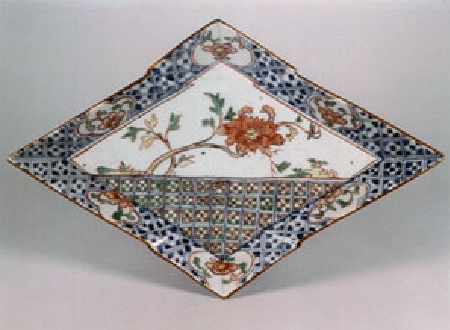 Shonzui-de style small dish, Underglaze geometrical pattern drawn by cobalt blue is typical , circa 1650It involved decorating pieces with colorful Chinese-style geometric patterns. "Shonzui" derived from the fact that this type of Chinese porcelain made in Jingdezhen around early 17th century bears auspicious omens Chinese characters on the center of the back. Syonzui style Chinese porcelain was highly acclaimed and imported by Samurai-class connoisseurs who liked "Kirei-Sabi" as utensils for the Japanese tea ceremony.
Shonzui-de style small dish, Underglaze geometrical pattern drawn by cobalt blue is typical , circa 1650It involved decorating pieces with colorful Chinese-style geometric patterns. "Shonzui" derived from the fact that this type of Chinese porcelain made in Jingdezhen around early 17th century bears auspicious omens Chinese characters on the center of the back. Syonzui style Chinese porcelain was highly acclaimed and imported by Samurai-class connoisseurs who liked "Kirei-Sabi" as utensils for the Japanese tea ceremony.
Gosai-de 五彩手
 Gosai-de dish bears the production year characters, 1652. The patterns are the Family Crest of Tokugawa Shogunate.It involved the application of uniquely Japanese designs that borrowed heavily from Chinese painting;
Gosai-de dish bears the production year characters, 1652. The patterns are the Family Crest of Tokugawa Shogunate.It involved the application of uniquely Japanese designs that borrowed heavily from Chinese painting;
Ao-de 青手
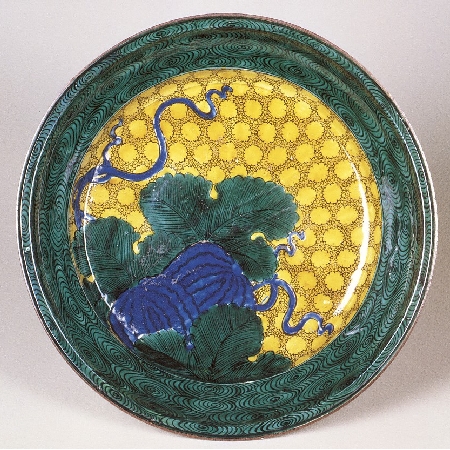 Ko-Kutani 'Ao-de' style dish, circa mid 17th century. Toguri Museum of Art. The style with an overwhelming presence that entailed filling the entire surface of each piece with yellow and green.
Ko-Kutani 'Ao-de' style dish, circa mid 17th century. Toguri Museum of Art. The style with an overwhelming presence that entailed filling the entire surface of each piece with yellow and green.
Kakiemon style (The second half of the 17th century)
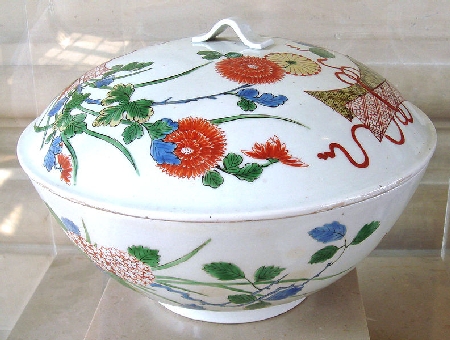 Kakiemon type porcelain bowl, circa 1645.In mid 17th century, Kakiemon 柿右衛門 style was started to be produced, mainly for export, at the factories of Arita from the mid-17th century. The Japanese potter Kakiemon Sakaida 酒井田柿右衛門 (1596–1666) is popularly credited with being one of the first in Japan to discover the secret of red color enamel decoration on porcelain, known as "Aka-e 赤絵" developed in China. The enamel decoration of Kakiemon style ware is with much in common with the Chinese "Famille Verte" style.
Kakiemon type porcelain bowl, circa 1645.In mid 17th century, Kakiemon 柿右衛門 style was started to be produced, mainly for export, at the factories of Arita from the mid-17th century. The Japanese potter Kakiemon Sakaida 酒井田柿右衛門 (1596–1666) is popularly credited with being one of the first in Japan to discover the secret of red color enamel decoration on porcelain, known as "Aka-e 赤絵" developed in China. The enamel decoration of Kakiemon style ware is with much in common with the Chinese "Famille Verte" style.
The red applied over the milk-white porcelain base known as nigoshide is almost vermillion, with brightly colored uwa-etsuke (overglaze enamels) a feature of the style. The designs, which are pictorial in style, include flowers and birds or landscapes and figures painted with large amounts of negative space.
The superb quality of its enamel decoration was highly prized in the West and widely imitated by the major European porcelain manufacturers in early 18th century.
Kinrande style (Late 17th to early 18th century)
Imari, Kinrande-style, in 18th century.From the end of 17th century, Kinrande 金襴手 (gold brocade style) style was started to produced.
with the Kakiemon style giving way in the 1690s to the emergence of blue-and-white sometsuke, polychrome iro-e, and gold-brocade kinrande ware. Most kinrande ware is broadly classified into pieces destined for the domestic market and pieces destined for the European market. These vessels, which are covered in colorful designs and feature the abundant use of gold, have a strong presence characterized by exuberance and depth.
Sometimes the Kinrande porcelain ware was signed as a style of Chinese Emperor Seal, "Made under Jiajing reign period 大明嘉靖年製" or "Made under Wanli reign period 大明萬暦年製", because the Kinrande design was inspired by Gold Wucai style in the Jiajing 嘉靖 (1522-1566) and Wanli 萬曆 (1573-1619) periods. However Imari Kinrande style was not similar to these Chinese porcelain, they did not imitate rather used the seal of Chinese emperor as a part of design.
Nabeshima ware (1651-1871)
Nabeshima ware is the term used to describe porcelain produced early in the Edo period by the Nabeshima clan, rulers of Japan's only porcelain producing area, by rounding up the most talented ceramicists from in and around the town of Arita in present-day Saga prefecture and putting them to work in kilns in Okawachiyama 大川内山 lacated in the mountainous are between Imari 伊万里 and Arita 有田. Unlike Imari ware, which was produced for the domestic markets. Nabeshima ware was produced using the finest materials and in accordance with the best techniques as gifts for the shogun, senior government officials, and other dignitaries.
The Start of Nabeshima ware
The Nabeshima clan used to present Chinese imported porcelain wares to Tokugawa Shogunate as a tribute to mend relations because they had fought with Tokugawa at the Battle of Sekigahara in 1600. During the Sekigahara Campaign Nabeshima Katsushige 鍋島勝茂 (1580–1657) sided with the western faction, attacking Fushimi Castle and AnNozu Castle, however he did not take part in the main action at Sekigahara. He submitted to Tokugawa Ieyasu very quickly afterward. In 1607 he was confirmed as daimyo of Saga-domain in 1607 and ruled until 1657.
In 1644, Nabeshima clan started trying to produce high quality porcelain by themselves because it had became impossible to import Chinese porcelain after the collapse of Ming Dynasty.
In 1651 Nabeshima clan re-started to present their home made porcelain "Nabeshima ware" to Tokugawa Shogunate.
The Establishment of the Official Kiln
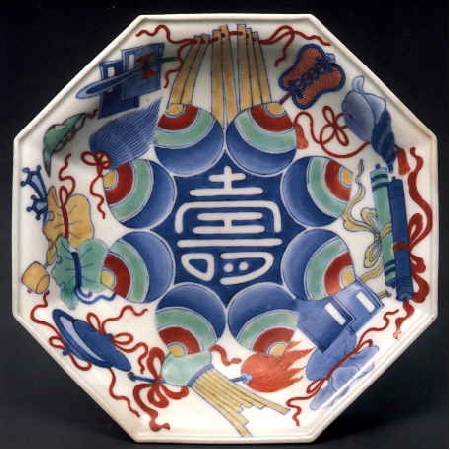 Nabeshima ware, Octagonal dish, decorated with design of treasures around the character "kotobuki" (felicitations) in underglaze blue and overglaze enamels. Late 17th to early 18th century. Toguri Museum of Art.In 1659 the Nabeshima clan started to consolidate porcelain production systems and established the domain-controlled official kiln specialized for Shogunate tribute products in Okawachiyama 大川内山 to prevent leakage of the manufacturing techniques. This official kiln was called Sara-yama 皿山 (Dishes Mountain).
Nabeshima ware, Octagonal dish, decorated with design of treasures around the character "kotobuki" (felicitations) in underglaze blue and overglaze enamels. Late 17th to early 18th century. Toguri Museum of Art.In 1659 the Nabeshima clan started to consolidate porcelain production systems and established the domain-controlled official kiln specialized for Shogunate tribute products in Okawachiyama 大川内山 to prevent leakage of the manufacturing techniques. This official kiln was called Sara-yama 皿山 (Dishes Mountain).
The mokuhai-gata dishes are in standardized sizes of five sun (approx. 15 cm), seven sun (approx. 20 cm), and a shaku (approx. 30 cm), and are adorned with delicate sometsuke, red, yellow, and green patterns applied using overglaze enamels.
The Nabeshima's official documentation written in 1693 survived. "Arita Sara-yama Daikan e ai-watashi tegashira utsushi 有田皿山代官江相渡手頭写" was the copy of the directions by 2nd generation of head of the Saga-domain Nabeshima Mitsushige 鍋島光茂 (1632-1700) to Sara-yama Daikan 皿山代官 (local governor of Sara-yama kiln). He expressed his frastration due to Tokugawa Shogunate saying that "It is so boaring to be presented dishes of the same design every year" and urged Sara-yama Daikan to apply new original and novelty designs even by stealing off the other kiln's designs. And also he ordered to keep secret the manufacturing techniques and maitain the high quality of Nabeshima-ware.
The workshop of the Okawachiyama kiln was organized as the production network based on the division of labor, consists of 9 woodturners 細工方, 4 shaping artizans 捻細工, 9 painters 画工, 7 helpers 下働き and 16 firing workers 御手伝窯焼. There were other various official responsibilities, like the official red color painter 御用赤絵屋、the official blacksmith 御用鍛冶屋、the official kaolin mining worker 御用土伐、the official mason 御用石工 and the firewood feller 薪方頭取.
The Perfection of Nabeshima Style
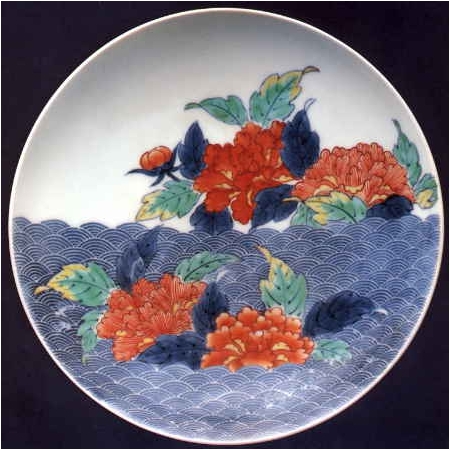 Nabeshima ware dish, circa Genroku era (1688-1704)For the latter part of 5th Edo Shogun Tokugawa Tsunayoshi(1680-1709) reign, he was advised by Yanagisawa Yoshiyasu. It was a golden era of classic Japanese art, known as the Genroku era (1688-1704). Tokugawa Tsunayoshi tried to strenghthen his power and visited Daimyo (Lord)'s houses in Edo quite oftenly then gave Daimyo Nabeshima-ware as a present.
Nabeshima ware dish, circa Genroku era (1688-1704)For the latter part of 5th Edo Shogun Tokugawa Tsunayoshi(1680-1709) reign, he was advised by Yanagisawa Yoshiyasu. It was a golden era of classic Japanese art, known as the Genroku era (1688-1704). Tokugawa Tsunayoshi tried to strenghthen his power and visited Daimyo (Lord)'s houses in Edo quite oftenly then gave Daimyo Nabeshima-ware as a present.
So the demand for Nabshima-ware increased rapidly and these situation lead to the perfection of the Iro-Nabeshima style.
The Prohibition of Iro-Nabeshima
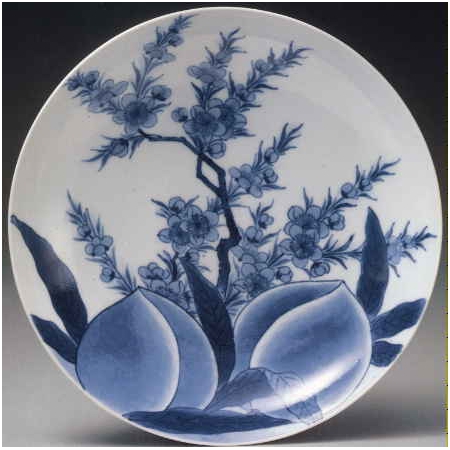 Nabeshima ware dish, circa Kyoho era (1716-45).Tokugawa Yoshimune (1684-1751) became 8th Edo Shogun in 1716. He dismissed the conservative adviser Arai Hakuseki and began what would come to be known as the Kyoho Financial Reforms. The reforms were aimed at making the shogunate financially solvent. Because of the tensions between Confucian ideology and the economic reality of Tokugawa Japan (Confucian principles that money was defiling vs. the necessity for a cash economy), Yoshimune found it necessary to shelve certain Confucian principles that were hampering his reform process.
Nabeshima ware dish, circa Kyoho era (1716-45).Tokugawa Yoshimune (1684-1751) became 8th Edo Shogun in 1716. He dismissed the conservative adviser Arai Hakuseki and began what would come to be known as the Kyoho Financial Reforms. The reforms were aimed at making the shogunate financially solvent. Because of the tensions between Confucian ideology and the economic reality of Tokugawa Japan (Confucian principles that money was defiling vs. the necessity for a cash economy), Yoshimune found it necessary to shelve certain Confucian principles that were hampering his reform process.
The Kyoho reforms included an emphasis on frugality, as well as the formation of merchant guilds that allowed greater control and taxation. Alternate attendance (sankin kōtai) rules were relaxed. Although foreign books had been strictly forbidden since 1640, Yoshimune relaxed the rules in 1720, starting an influx of foreign books and their translations into Japan, and initiating the development of Western studies, or rangaku 蘭学.
Tokugawa Yoshimune prohibited coulorful Iro-Nabeshima as being gaudy or showy. So most of Nabeshima ware in this period were blue-and-white style.
The Deterioration of Nabeshima kiln
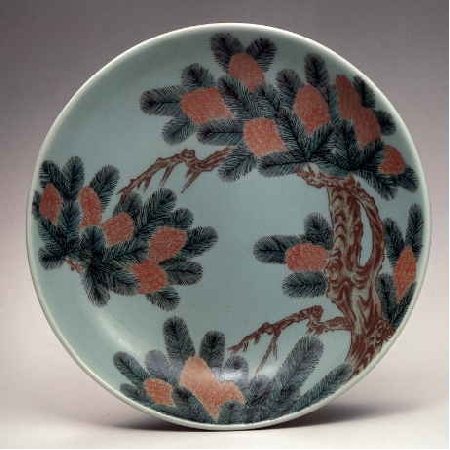 Nabeshima ware dish, circa Tenmei era (1751-77).Tokugawa Ieharu 徳川家治 (1737-86) became the 10th Edo Shogun in 1760. Under his reign, Tanuma Okitsugu 田沼意次 (1719-1788) grasped the power, who was a Rojyu (senior counselor) of the Tokugawa shogunate and a Daimyo ruling the Sagara han. He introduced monetary reform however his regime is often identified with rampant corruption and huge inflation of currency.
Nabeshima ware dish, circa Tenmei era (1751-77).Tokugawa Ieharu 徳川家治 (1737-86) became the 10th Edo Shogun in 1760. Under his reign, Tanuma Okitsugu 田沼意次 (1719-1788) grasped the power, who was a Rojyu (senior counselor) of the Tokugawa shogunate and a Daimyo ruling the Sagara han. He introduced monetary reform however his regime is often identified with rampant corruption and huge inflation of currency.
Tokugawa Ieharu specified his favorite 12 designs for Nabeshima ware. His designs became new style but lead to the detarioration of Nabeshima ware.
Chinese Porcelain with the decorative technique of coloring
This enamel decoration techniques was originally developed by Chinese.
Doucai 闘彩/豆彩
 Doucai Cup, Ming dynasty, Chenghua Period (1465-87), The Metropolitan Museum of ArtDoucai 闘彩/豆彩 ware is a type of decorated porcelain that had the outlines painted in a cobalt-blue and covered with a transparent glaze before the first firing. It was then fired again at a low temperature after the overglaze enamels of red, yellow, and green were applied. Doucai-ware is also called "contending colors" (in Chinese, the phrases "bean color" and "contending colors" both have the same sound). The production techniques of the doucai-ware began in the Xuande 宣德 period (1426-35) and culminated in the Chenghua 成化 period (1465-87), during the Ming Dynasty.
Doucai Cup, Ming dynasty, Chenghua Period (1465-87), The Metropolitan Museum of ArtDoucai 闘彩/豆彩 ware is a type of decorated porcelain that had the outlines painted in a cobalt-blue and covered with a transparent glaze before the first firing. It was then fired again at a low temperature after the overglaze enamels of red, yellow, and green were applied. Doucai-ware is also called "contending colors" (in Chinese, the phrases "bean color" and "contending colors" both have the same sound). The production techniques of the doucai-ware began in the Xuande 宣德 period (1426-35) and culminated in the Chenghua 成化 period (1465-87), during the Ming Dynasty.
Wucai 五彩
 Wucai ware, a covered jar decorated with goldfish and aquatic plants, Ming dynasty, reign of the Jiajing emperor (1522-1566). Porcelain with overlay enamels, H: 46 cm. National Museum of Chinese History, Beijing.Wucai 五彩 (Five colors) ware became especially popular in the Jiajing 嘉靖 (1522-1566) and Wanli 萬曆 (1573-1619) periods of mid to late Ming dynasty (1368–1644). To produce Wucai ware an underglaze of cobalt blue was laid down, and then three or more lower-fired, fairly pale, transparent enamels were painted on top of the glaze. This was a laborious process that required a second firing. The overglaze colors were applied in more or less equal proportions so that no one color dominated. Wucai colors tend to be bright and flat (rather than gradated). Ming Wucai typically combines underglaze blue with red and yellow or red and green.
Wucai ware, a covered jar decorated with goldfish and aquatic plants, Ming dynasty, reign of the Jiajing emperor (1522-1566). Porcelain with overlay enamels, H: 46 cm. National Museum of Chinese History, Beijing.Wucai 五彩 (Five colors) ware became especially popular in the Jiajing 嘉靖 (1522-1566) and Wanli 萬曆 (1573-1619) periods of mid to late Ming dynasty (1368–1644). To produce Wucai ware an underglaze of cobalt blue was laid down, and then three or more lower-fired, fairly pale, transparent enamels were painted on top of the glaze. This was a laborious process that required a second firing. The overglaze colors were applied in more or less equal proportions so that no one color dominated. Wucai colors tend to be bright and flat (rather than gradated). Ming Wucai typically combines underglaze blue with red and yellow or red and green.
Famille Verte
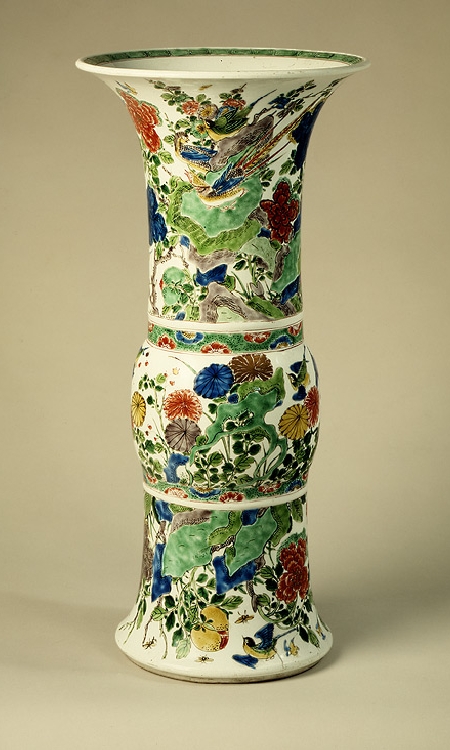 Famile Verte Vase, Kangxi seal and period, late 17th century to early 18th century. The Metropolitan Museum of Art.During Kangxi康熙 (1662–1722) period of Qing dynasty (1644–1911) a more varied palette using green and iron red with other overglaze colours was developed from Wucai. The use of underglaze blue gradually gave way to blue overglaze enamel, the enamel colors became more opaque (yielding stronger yellows and greens), and underglaze blue was used as an outline for solid opaque enamel masses of color. Qing dynasty wucai type may also employ black to define outlines, and may include gold decoration. This type of porcelain exported by the Dutch East Indian Company into Europe was called "Famille Verte".
Famile Verte Vase, Kangxi seal and period, late 17th century to early 18th century. The Metropolitan Museum of Art.During Kangxi康熙 (1662–1722) period of Qing dynasty (1644–1911) a more varied palette using green and iron red with other overglaze colours was developed from Wucai. The use of underglaze blue gradually gave way to blue overglaze enamel, the enamel colors became more opaque (yielding stronger yellows and greens), and underglaze blue was used as an outline for solid opaque enamel masses of color. Qing dynasty wucai type may also employ black to define outlines, and may include gold decoration. This type of porcelain exported by the Dutch East Indian Company into Europe was called "Famille Verte".
Seiji Yamauchi
 Top
Top Site Map
Site Map References
References About Me
About Me